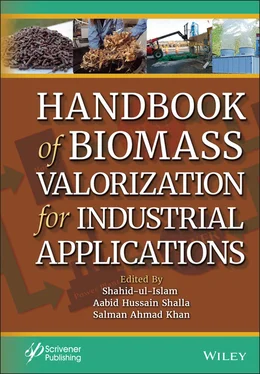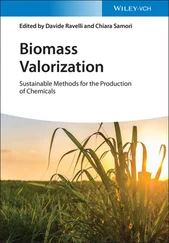Handbook of Biomass Valorization for Industrial Applications
Здесь есть возможность читать онлайн «Handbook of Biomass Valorization for Industrial Applications» — ознакомительный отрывок электронной книги совершенно бесплатно, а после прочтения отрывка купить полную версию. В некоторых случаях можно слушать аудио, скачать через торрент в формате fb2 и присутствует краткое содержание. Жанр: unrecognised, на английском языке. Описание произведения, (предисловие) а так же отзывы посетителей доступны на портале библиотеки ЛибКат.
- Название:Handbook of Biomass Valorization for Industrial Applications
- Автор:
- Жанр:
- Год:неизвестен
- ISBN:нет данных
- Рейтинг книги:4 / 5. Голосов: 1
-
Избранное:Добавить в избранное
- Отзывы:
-
Ваша оценка:
- 80
- 1
- 2
- 3
- 4
- 5
Handbook of Biomass Valorization for Industrial Applications: краткое содержание, описание и аннотация
Предлагаем к чтению аннотацию, описание, краткое содержание или предисловие (зависит от того, что написал сам автор книги «Handbook of Biomass Valorization for Industrial Applications»). Если вы не нашли необходимую информацию о книге — напишите в комментариях, мы постараемся отыскать её.
BIOMASS VALORIZATION
INDUSTRIAL APPLICATIONS
The handbook provides a comprehensive view of cutting-edge research on biomass valorization, from advanced fabrication methodologies through useful derived materials, to current and potential application sectors.
Audience Handbook of Biomass Valorization for Industrial Applications
Handbook of Biomass Valorization for Industrial Applications — читать онлайн ознакомительный отрывок
Ниже представлен текст книги, разбитый по страницам. Система сохранения места последней прочитанной страницы, позволяет с удобством читать онлайн бесплатно книгу «Handbook of Biomass Valorization for Industrial Applications», без необходимости каждый раз заново искать на чём Вы остановились. Поставьте закладку, и сможете в любой момент перейти на страницу, на которой закончили чтение.
Интервал:
Закладка:
Keywords: Waste to energy, biomass waste, carbon materials, glycerol valorization, biodiesel industry up gradation
4.1 Introduction
With the continuously rising population, rapid industrialization, and improving the standard of living, worldwide energy consumption is increasing at a high rate and projected to become more than double (~1.1 × 1,021 J per hour) by 2050 [1]. Despite enormous efforts to develop alternative energy resources, fossil fuels are estimated to continue as the major energy source for the near future. The widespread utilization of fossil fuels to meet the growing demand for energy has adverse effects due to significant greenhouse gases emission and the exhaustion of these resources. Therefore, the growth and utilization of sustainable resources of energy have become a subject of international importance [2].
Recently, biomass has received tremendous interest from researchers as an alternative feedstock for sustainable and clean energy production [3]. Biodiesel production using biomass is a sustainable approach due to its use as renewable, non-toxic, and biodegradable fuel with a small emission of air pollutants as compared to petroleum-based fuels [4]. Biodiesel is environmentally friendly due to small carbon monoxide and particulate matter emissions and does not release hydrocarbons [5]. The increased production of oxygen in the case of biodiesel leads to complete combustion [5]. The vital feedstock for biodiesel production is animal fat, vegetable oil, or waste cooking oil. The productions of biodiesel have increased drastically for the past few years due to its direct use in diesel engines without modifications [6]. However, the formation of biodiesel by transesterification of animal fats or vegetable oils as a raw feedstock produces approximately 10 wt% glycerol (1,2,3-propanetriol) as a by-product which increases its manufacturing cost [7]. This is bottleneck of the technology. A glycerol glut exists in the global market due to the fast growth in biodiesel production. Therefore, the biodiesel industry needs to produce valuable products from glycerol and make it more competitive with conventional diesel fuel. It is also important from an environmental and economic viewpoint [8].
The continuous increase in biodiesel demand will also generate a huge amount of glycerol and therefore, it needs to be utilized [9]. According to 2011 data, globally the total amount of glycerol produced by the biodiesel industry is 66.2%. In the world, the largest biodiesel-producing countries are the United States and Brazil [10]. In the USA, biodiesel consumption increases from 878 million gallons in 2011 to 1,725 million gallons in 2019. To address this issue, the US Department of Energy declared glycerol as a major building block platform chemical for the future. Therefore, the transformation of glycerol to valuable products is a rapidly growing research area that decreases the expenditure of biodiesel production [7, 11].
The transformation of glycerol into valuable products is essential for the industries because a huge amount of glycerol that is generated through biodiesel production and fermentation of sugars can be utilized judiciously. Moreover, glycerol is a non-hazardous, biodegradable, and bio sustainable compound. Economic and technical analyses indicate that the low cost of glycerol and its multifunctional structure could open a new market for valuable commodity chemicals. Furthermore, glycerol conversion into profitable chemicals and fuels (syngas/hydrogen) will facilitate the substitution of petroleum-based products as well as promote the utilization of clean energy resources [8]. However, glycerol must be purified before any attempt to transform it into value-added products. Many different reaction pathways (biological, thermocatalytic, etc.) have been investigated to derive the various chemicals starting from glycerol. Of the various methodologies, the use of catalysis represents an efficient approach for this purpose.
Recently, several novel catalytic transformation processes have been reported in the literature. Glycerol is mainly transformed into useful chemicals using steam reforming, esterification, hydrogenolysis, dehydration, oxidation, carboxylation, etherification, and acetalization [9, 12, 13]. A large variety of valuable derivatives, such as fine chemicals, polymers, fuels, and fuel additives have been achieved. A wide spectrum of catalysts such as metal, metal salt, metal oxides, resins, zeolite, heteropolyacids, sulfonic acid, metal sulfides, and carbon catalysts have been utilized for the efficient conversion of glycerol into value-added products [12, 13]. Carbon-based catalysts have added benefits compared to metal-based catalysts due to their high durability, better textural properties, easy availability, and low cost. Carbon-based catalysts have been used as a catalyst as well as support for different transformation processes. This chapter explains the fundamentals, mechanism, and latest development in the transformation of glycerol into valuable products over carbon-based catalysts. The earlier reported works demonstrated the possibility of the establishment of several new catalytic approaches and value-added products from glycerol. Interestingly, there are still a lot of opportunities available for researchers to design novel carbon-based catalysts and develop new methodologies for glycerol conversion.
4.2 Production of Biodiesel and Crude Glycerol
Worldwide biodiesel production has been rising extensively in the last few years. In 2018, the top five biodiesel producing nations were the United States (US), Argentina, Brazil, Germany, and China [10]. Both the US and Brazil have accounted for a combined share of nearly 87% of the total production in 2018. It is predicted that in the near future, the annual production of biodiesel will rise by approximately 4.5% [10]. Biodiesel is mainly produced from a broad diversity of materials that contains triglycerides as a key component. This can be produced by vegetable oils from jatropha, sunflower, babassu, soybean, macauba, palm, oilseed radish, canola, crambe, castor bean, peanut, and lupine [4]. Alternatively, it can also be produced from photosynthetic algae, animal fat, and waste cooking oil. The transesterification or esterification of triglycerides with alcohol (methanol) produces methyl esters of fatty acids (biodiesel) and glycerol as depicted in Figure 4.1. The catalysts used for transesterification are mainly alkalis, acids, or enzymes.
The transesterification reaction takes place in three steps as shown in Figure 4.2in which triglycerides react with methanol. First, the reaction involves the conversion of triglycerides into diglycerides which then get converted into monoglycerides. Finally, the monoglycerides transformed into glycerol. The overall reaction is reversible, so, plenty of alcohol is required to favor the reaction in the forward direction. The theoretical stoichiometric ratio for the conversion is 1:3 (triglycerides: alcohol), but for practical applications surplus amount of alcohol is required to shift the equilibrium in the direction of the product. Overall, for the formation of 9 kg of biodiesel, approximately 1 kg of glycerol is generated [5].
The flow chart for the formation of biodiesel and byproduct glycerol is shown in Figure 4.3.
The commonly used catalyst during biodiesel production is NaOH which leads to the generation of faulty smell, dark-colored glycerol with high pH. The crude glycerol produced during the production of biodiesel contains impurities including catalyst salts, unreacted glycerides, and water depending upon the nature of oil and technology employed. The amount of glycerol in crude glycerol may vary from 45 to 90% depending upon the reaction conditions [5, 6]. Upgrading and refining crude glycerol are necessary to minimize waste production. The industrial-grade glycerol can be obtained by filtration, extraction, and distillation. The glycerol produced from different bio-refineries has a different composition, so it is complicated to outline the properties of crude glycerol. The properties of pure glycerol are outlined in Table 4.1. There are many commercial grades of glycerol; it is named glycerin if the concentration of glycerol is above 95%. The structure of glycerol is shown in Figure 4.4. It is miscible in water due to the presence of hydrophilic hydroxyl groups. It is a colorless, unscented thick fluid having a boiling and melting point of 290 and 17.9 °C, respectively.
Читать дальшеИнтервал:
Закладка:
Похожие книги на «Handbook of Biomass Valorization for Industrial Applications»
Представляем Вашему вниманию похожие книги на «Handbook of Biomass Valorization for Industrial Applications» списком для выбора. Мы отобрали схожую по названию и смыслу литературу в надежде предоставить читателям больше вариантов отыскать новые, интересные, ещё непрочитанные произведения.
Обсуждение, отзывы о книге «Handbook of Biomass Valorization for Industrial Applications» и просто собственные мнения читателей. Оставьте ваши комментарии, напишите, что Вы думаете о произведении, его смысле или главных героях. Укажите что конкретно понравилось, а что нет, и почему Вы так считаете.












